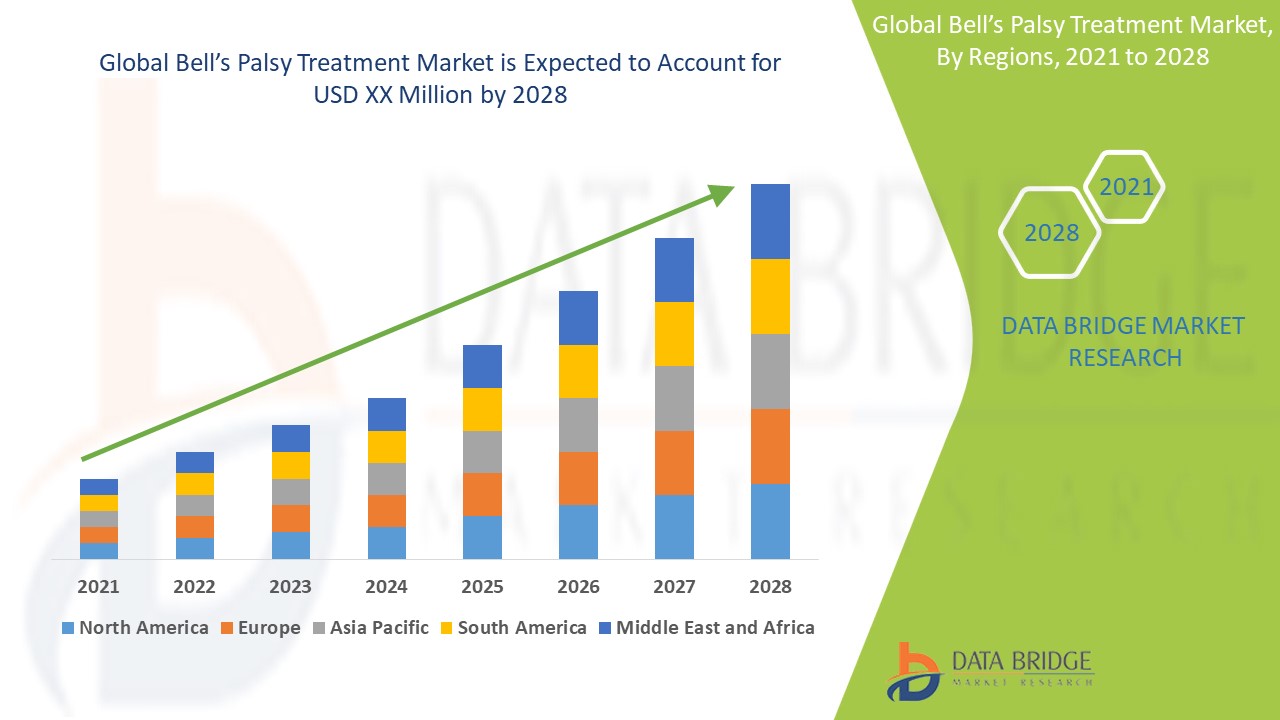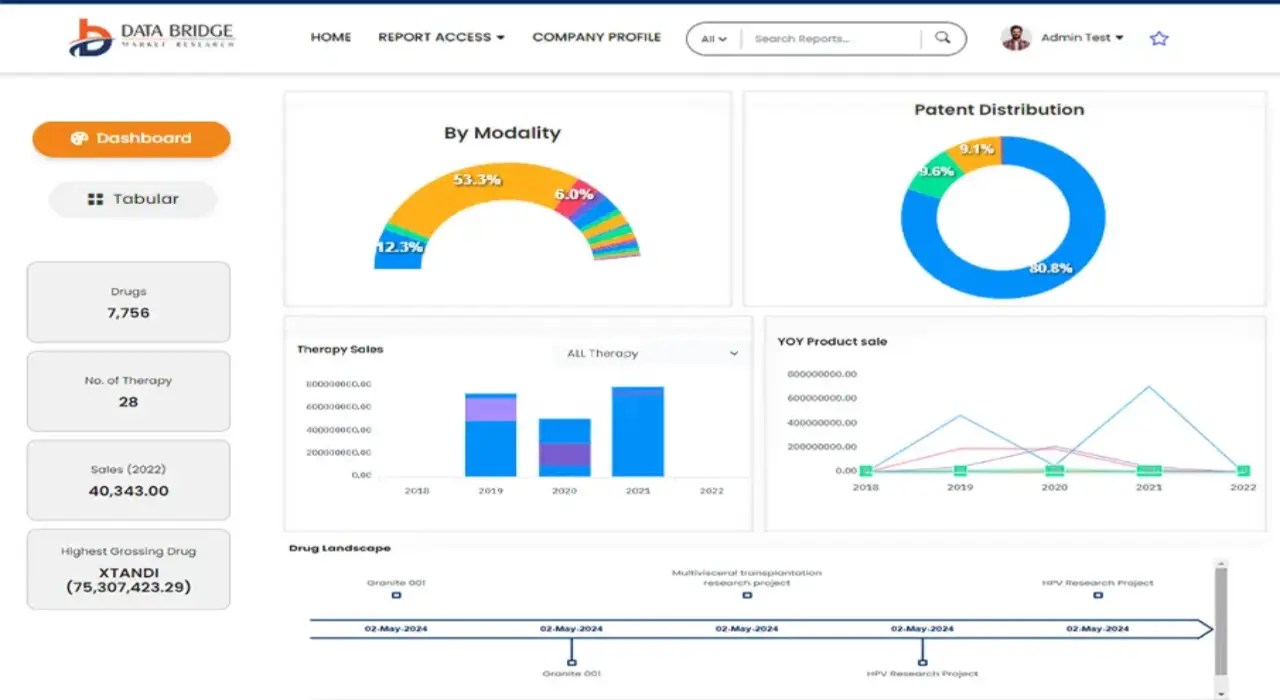Global Bells Palsy Treatment Market
Tamanho do mercado em biliões de dólares
CAGR :
% 
 USD
2.64 Billion
USD
4.12 Billion
2024
2032
USD
2.64 Billion
USD
4.12 Billion
2024
2032
| 2025 –2032 | |
| USD 2.64 Billion | |
| USD 4.12 Billion | |
|
|
|
|
Global Bell’s Palsy Treatment Market Segmentation, By Treatment Type (Medication, Physical Therapy, and Others), Drug Class Type (Corticosteroids, Anticonvulsants, Antibacterial, and Others), Drugs (Acyclovir, Prednisone, and Others), Route of Administration (Injectable, Orals, and Others), End Users (Hospitals, Homecare, Specialty Clinics, and Others), Distribution Channel (Hospital Pharmacy, Retail Pharmacy, Online Pharmacy, and Others) – Industry Trends and Forecast to 2032
Bell’s Palsy Treatment Market Analysis
The bell’s palsy treatment market has seen steady growth due to the increasing prevalence of the condition, which is caused by the inflammation of the facial nerve. This market is driven by the growing awareness of early diagnosis and the availability of effective treatments. Corticosteroids, antiviral drugs, and physical therapy are among the primary treatment options, which help manage symptoms and improve recovery outcomes. Recent advancements include the development of targeted therapies and the increasing use of facial nerve stimulation for rehabilitation. In addition, innovations in diagnostic imaging techniques have contributed to faster and more accurate diagnoses, further driving the market. The demand for treatments is expected to rise with the increasing healthcare infrastructure and better access to care, particularly in emerging markets. Key players in the market include pharmaceutical companies, healthcare providers, and medical device manufacturers working to expand treatment options and improve patient outcomes.
Bell’s Palsy Treatment Market Size
The global bell’s palsy treatment market size was valued at USD 2.64 billion in 2024 and is projected to reach USD 4.12 billion by 2032, with a CAGR of 5.70% during the forecast period of 2025 to 2032. In addition to the insights on market scenarios such as market value, growth rate, segmentation, geographical coverage, and major players, the market reports curated by the Data Bridge Market Research also include depth expert analysis, patient epidemiology, pipeline analysis, pricing analysis, and regulatory framework.
Bell’s Palsy Treatment Market Trends
“Innovations in Treatment Options”
The bell’s palsy treatment market is evolving with a focus on improving recovery outcomes and minimizing long-term facial nerve damage. Innovations in treatment options, including the development of corticosteroid therapies and antiviral drugs, have enhanced the effectiveness of early interventions. A key trend in the market is the increasing use of facial nerve stimulation and rehabilitation techniques, which improve motor function and help reduce the severity of symptoms. In addition, advancements in diagnostic tools enable quicker and more accurate identification of bell’s palsy, leading to better treatment outcomes. As healthcare access expands globally, especially in emerging markets, the bell’s palsy treatment market is expected to continue to grow with new innovations and increased awareness about the condition.
Report Scope and Bell’s Palsy Treatment Market Segmentation
|
Attributes |
Bell’s Palsy Treatment Key Market Insights |
|
Segments Covered |
|
|
Countries Covered |
U.S., Canada and Mexico in North America, Germany, France, U.K., Netherlands, Switzerland, Belgium, Russia, Italy, Spain, Turkey, Rest of Europe in Europe, China, Japan, India, South Korea, Singapore, Malaysia, Australia, Thailand, Indonesia, Philippines, Rest of Asia-Pacific (APAC) in the Asia-Pacific (APAC), Saudi Arabia, U.A.E., South Africa, Egypt, Israel, Rest of Middle East and Africa (MEA) as a part of Middle East and Africa (MEA), Brazil, Argentina and Rest of South America as part of South America. |
|
Key Market Players |
Kapioshealth (U.S.), MEDSTAR HEALTH (U.S.), Atlantic Health System (U.S.), Sanofi (France), Regeneron Pharmaceuticals Inc. (U.S.), AbbVie Inc. (U.S.), Amneal Pharmaceuticals LLC (U.S.), Sun Pharmaceutical Industries Ltd. (India), Bristol-Myers Squibb and Company (U.S.), Eli Lilly and Company (U.S.), Taro Pharmaceutical Industries Ltd. (Israel), Bausch Health Companies Inc. (Canada), Viatris Inc. (U.S.), Johnson & Johnson Services, Inc. (U.S.), GSK Plc (U.K.), Bayer AG (Germany), Novartis AG (Switzerland), Teva Pharmaceutical Industries Ltd. (Israel), Gilead Sciences, Inc. (U.S.) |
|
Market Opportunities |
|
|
Value Added Data Infosets |
In addition to the insights on market scenarios such as market value, growth rate, segmentation, geographical coverage, and major players, the market reports curated by the Data Bridge Market Research also include depth expert analysis, patient epidemiology, pipeline analysis, pricing analysis, and regulatory framework. |
Bell’s Palsy Treatment Market Definition
Bell's palsy treatment refers to medical interventions aimed at alleviating the symptoms and promoting recovery from Bell's palsy, a condition that causes sudden, temporary weakness or paralysis of one side of the face due to inflammation of the facial nerve. Treatment typically involves corticosteroids to reduce inflammation and antiviral medications if a viral infection is suspected. In some cases, physical therapy, facial exercises, and nerve stimulation may be used to help restore muscle function and improve facial symmetry. Early intervention is critical for improving recovery outcomes and reducing the risk of long-term complications, such as permanent facial nerve damage.
Bell’s Palsy Treatment Market Dynamics
Drivers
- Rising Incidence of Bell’s Pals
The growing prevalence of Bell’s palsy, particularly in younger populations, has significantly contributed to the demand for effective treatments. Viral infections, especially the herpes simplex virus, are a major cause of this condition, which affects facial nerves, leading to sudden facial paralysis. As the incidence of Bell’s palsy increases, the need for prompt and effective treatments becomes more crucial. This has led to greater demand for medications such as corticosteroids and antiviral drugs, along with rehabilitation therapies, to manage symptoms and improve recovery. The rising cases of Bell’s palsy are a key driver propelling market growth for treatment options.
- Increasing Healthcare Expenditure
Rising healthcare investments and improved access to healthcare services in both developed and emerging markets are significantly enhancing the treatment accessibility for bell’s palsy patients. Increased funding in healthcare infrastructure, coupled with advancements in medical technologies, has allowed for better diagnosis and management of the condition. In regions with growing healthcare capabilities, patients are now able to receive timely treatments such as corticosteroids and antiviral medications, which help improve recovery rates. This trend is accelerating the growth of the Bell’s palsy treatment market by expanding the reach of effective therapies and improving patient outcomes across various regions.
Opportunities
- Rise of Telemedicine
The rise of telemedicine is transforming healthcare by offering remote consultations, making it easier for patients with Bell's palsy to access treatment from home. This is especially beneficial for individuals in remote or underserved areas who may have limited access to healthcare facilities. Through telemedicine, patients can receive timely medical advice, follow-up care, and prescriptions, improving their overall management of the condition. In addition, healthcare providers can monitor patient progress remotely, ensuring better treatment adherence and outcomes. This shift towards virtual healthcare is expected to increase treatment accessibility, driving growth in the bell’s palsy treatment market.
- Advancement in Diagnostic Tools
Advancements in diagnostic tools, particularly MRI and electrodiagnostic tests, have significantly improved the ability to detect Bell's palsy at earlier stages. Early and accurate diagnosis allows healthcare providers to initiate treatment promptly, which is crucial for reducing complications and enhancing patient recovery. The use of these advanced diagnostic tools ensures that patients receive timely intervention, increasing the likelihood of positive outcomes. As a result, the demand for effective treatment options is expected to rise, presenting a significant growth opportunity for the Bell’s palsy treatment market. Early detection improves recovery rates and drives the need for better treatment solutions.
Restraints/Challenges
- Limited Treatment Options
The current treatment for Bell’s Palsy primarily involves corticosteroids, which help reduce inflammation, and physical therapy to improve facial muscle function. However, for patients who do not respond well to these standard treatments, options are limited. This lack of alternative therapies presents a significant challenge in the market, as many patients may not experience complete recovery or may face prolonged symptoms despite treatment. Furthermore, corticosteroids can have side effects, which may deter some patients from following prescribed regimens. The limited availability of effective treatment options for non-responders creates a barrier to improving patient outcomes and market expansion.
- High Cost of Advanced Treatments
Newer treatments for Bell’s Palsy, such as botulinum toxin injections and antiviral drugs, offer potential benefits, particularly in cases where standard treatments such as corticosteroids are not effective. However, these therapies can be significantly more expensive than traditional options, making them less accessible for many patients, especially in lower-income regions. The high cost of these treatments acts as a market restraint, as it limits the number of individuals who can afford advanced care. This financial barrier contributes to unequal access to potentially more effective therapies, hindering the broader adoption and growth of these newer treatments in the market.
This market report provides details of new recent developments, trade regulations, import-export analysis, production analysis, value chain optimization, market share, impact of domestic and localized market players, analyses opportunities in terms of emerging revenue pockets, changes in market regulations, strategic market growth analysis, market size, category market growths, application niches and dominance, product approvals, product launches, geographic expansions, technological innovations in the market. To gain more info on the market contact Data Bridge Market Research for an Analyst Brief, our team will help you take an informed market decision to achieve market growth.
Bell’s Palsy Treatment Market Scope
The market is segmented on the basis of treatment type, drug class type, drugs, route of administration, end users, and distribution channel. The growth amongst these segments will help you analyse meagre growth segments in the industries and provide the users with a valuable market overview and market insights to help them make strategic decisions for identifying core market applications.
Treatment Type
- Medication
- Physical Therapy
- Others
Drug Class Type
- Corticosteroids
- Anticonvulsants
- Antibacterial
- Others
Drugs
- Acyclovir
- Prednisone
- Others
Route of Administration
- Injectable
- Orals
- Others
End Users
- Hospitals
- Homecare
- Specialty Clinics
- Others
Distribution Channel
- Hospital Pharmacy
- Retail Pharmacy
- Online Pharmacy
- Others
Bell’s Palsy Treatment Market Regional Analysis
The market is analysed and market size insights and trends are provided by country, treatment type, drug class type, drugs, route of administration, end users, and distribution channel as referenced above.
The countries covered in the market report are U.S., Canada and Mexico in North America, Germany, France, U.K., Netherlands, Switzerland, Belgium, Russia, Italy, Spain, Turkey, Rest of Europe in Europe, China, Japan, India, South Korea, Singapore, Malaysia, Australia, Thailand, Indonesia, Philippines, Rest of Asia-Pacific (APAC) in the Asia-Pacific (APAC), Saudi Arabia, U.A.E., South Africa, Egypt, Israel, Rest of Middle East and Africa (MEA) as a part of Middle East and Africa (MEA), Brazil, Argentina and Rest of South America as part of South America.
North America dominates the Bell's Palsy treatment market, driven by a growing preference for minimally invasive procedures and advancements in medical technology. The region benefits from strong government support for healthcare initiatives, which further boosts market growth. In addition, the rising demand for innovative treatments contributes to the region’s dominance in the market.
Asia Pacific region is expected to experience substantial growth in the Bell’s Palsy treatment market, fueled by growing awareness of health issues and available treatment options. As awareness of Bell’s Palsy and its treatment increases, more individuals are seeking medical care. In addition, the introduction of new and effective treatment methods is further driving market expansion in the region.
The country section of the report also provides individual market impacting factors and changes in regulation in the market domestically that impacts the current and future trends of the market. Data points such as down-stream and upstream value chain analysis, technical trends and porter's five forces analysis, case studies are some of the pointers used to forecast the market scenario for individual countries. Also, the presence and availability of global brands and their challenges faced due to large or scarce competition from local and domestic brands, impact of domestic tariffs and trade routes are considered while providing forecast analysis of the country data.
Bell’s Palsy Treatment Market Share
The market competitive landscape provides details by competitor. Details included are company overview, company financials, revenue generated, market potential, investment in research and development, new market initiatives, global presence, production sites and facilities, production capacities, company strengths and weaknesses, product launch, product width and breadth, application dominance. The above data points provided are only related to the companies' focus related to market.
Bell’s Palsy Treatment Market Leaders Operating in the Market Are:
- Kapioshealth (U.S.)
- MEDSTAR HEALTH (U.S.)
- Atlantic Health System (U.S.)
- Sanofi (France)
- Regeneron Pharmaceuticals Inc. (U.S.)
- AbbVie Inc. (U.S.)
- Amneal Pharmaceuticals LLC (U.S.)
- Sun Pharmaceutical Industries Ltd. (India)
- Bristol-Myers Squibb and Company (U.S.)
- Eli Lilly and Company (U.S.)
- Taro Pharmaceutical Industries Ltd. (Israel)
- Bausch Health Companies Inc. (Canada)
- Viatris Inc. (U.S.)
- Johnson & Johnson Services, Inc. (U.S.)
- GSK Plc (U.K.)
- Bayer AG (Germany)
- Novartis AG (Switzerland)
- Teva Pharmaceutical Industries Ltd. (Israel)
- Gilead Sciences, Inc. (U.S.)
Latest Developments in Bell’s Palsy Treatment Market
- In April 2023, research published in JAMA Otolaryngology - Head and Neck Surgery examined Bell’s Palsy incidence among COVID-19 vaccine recipients. While randomized trials showed a higher incidence in vaccinated individuals, observational studies found no significant association. The study also indicated that Bell’s Palsy occurred more frequently during COVID-19 infection than after vaccination, with a higher risk linked to the infection itself, not the vaccine. Further research is needed to fully understand these findings and explore why some individuals develop Bell’s Palsy post-vaccination
- In July 2020, surgeons at UT Southwestern developed a groundbreaking technique for Bell’s Palsy patients, enabling more effective eye closure and corneal protection. This innovative procedure, which reinnervates eye muscles, has proven most effective for patients with paralysis lasting under 18 months. Research highlights that the technique leads to faster, more complete eye closure, marking a significant advancement in Bell’s Palsy treatment and reinforcing UT Southwestern's leadership in reconstructive surgery and medical research
- In March 2021, Fujifilm Corporation, a leading Japan-based imaging and information solutions provider, acquired Hitachi Ltd.'s diagnostic imaging business for JPY 179 billion ($1.14 billion). This strategic acquisition included Hitachi’s CT, MRI, X-ray, and ultrasound systems, aimed at strengthening Fujifilm’s medical systems division. Hitachi, known for its imaging equipment, plays a significant role in the diagnosis of Bell's Palsy, and this acquisition expands Fujifilm's capabilities in the healthcare sector
SKU-
Obtenha acesso online ao relatório sobre a primeira nuvem de inteligência de mercado do mundo
- Painel interativo de análise de dados
- Painel de análise da empresa para oportunidades de elevado potencial de crescimento
- Acesso de analista de pesquisa para personalização e customização. consultas
- Análise da concorrência com painel interativo
- Últimas notícias, atualizações e atualizações Análise de tendências
- Aproveite o poder da análise de benchmark para um rastreio abrangente da concorrência
Metodologia de Investigação
A recolha de dados e a análise do ano base são feitas através de módulos de recolha de dados com amostras grandes. A etapa inclui a obtenção de informações de mercado ou dados relacionados através de diversas fontes e estratégias. Inclui examinar e planear antecipadamente todos os dados adquiridos no passado. Da mesma forma, envolve o exame de inconsistências de informação observadas em diferentes fontes de informação. Os dados de mercado são analisados e estimados utilizando modelos estatísticos e coerentes de mercado. Além disso, a análise da quota de mercado e a análise das principais tendências são os principais fatores de sucesso no relatório de mercado. Para saber mais, solicite uma chamada de analista ou abra a sua consulta.
A principal metodologia de investigação utilizada pela equipa de investigação do DBMR é a triangulação de dados que envolve a mineração de dados, a análise do impacto das variáveis de dados no mercado e a validação primária (especialista do setor). Os modelos de dados incluem grelha de posicionamento de fornecedores, análise da linha de tempo do mercado, visão geral e guia de mercado, grelha de posicionamento da empresa, análise de patentes, análise de preços, análise da quota de mercado da empresa, normas de medição, análise global versus regional e de participação dos fornecedores. Para saber mais sobre a metodologia de investigação, faça uma consulta para falar com os nossos especialistas do setor.
Personalização disponível
A Data Bridge Market Research é líder em investigação formativa avançada. Orgulhamo-nos de servir os nossos clientes novos e existentes com dados e análises que correspondem e atendem aos seus objetivos. O relatório pode ser personalizado para incluir análise de tendências de preços de marcas-alvo, compreensão do mercado para países adicionais (solicite a lista de países), dados de resultados de ensaios clínicos, revisão de literatura, mercado remodelado e análise de base de produtos . A análise de mercado dos concorrentes-alvo pode ser analisada desde análises baseadas em tecnologia até estratégias de carteira de mercado. Podemos adicionar quantos concorrentes necessitar de dados no formato e estilo de dados que procura. A nossa equipa de analistas também pode fornecer dados em tabelas dinâmicas de ficheiros Excel em bruto (livro de factos) ou pode ajudá-lo a criar apresentações a partir dos conjuntos de dados disponíveis no relatório.














